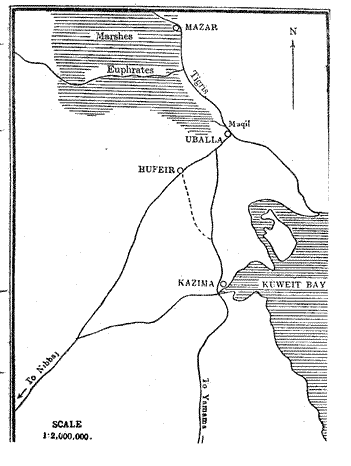|
Hormuz was the military
governor of Dast Meisan. An experienced veteran and a trusted servant
of the Empire. Hormuz was given this district to govern and protect
because of its vital importance, which was both political and economic.
It was a frontier district and lately had had a good deal of trouble
with the Arab raiders of Muthanna. It was also a wealthy district
in natural produce and commerce. Its chief city, Uballa, was the
main port of the Persian Empire and thus vital to its commercial
prosperity. Uballa was also a junction of many land routes-from
Bahrain, from Arabia, from Western and Central Iraq, from Persia
proper, which gave it a decisive strategical importance. It was
a gateway, which it was the job of Hormuz to govern as an administrator
and defend as a general.
The Persian society of the time had an imperial
and aristocratic character. As is inevitable in such societies,
it had an elaborate system of ranks to indicate a man's social and
official position at the court. The outward symbol of rank was the
cap; as a man rose in rank, his cap became more costly. The highest
rank below the Emperor carried a cap worth 100,000 dirhams, which
was studded with diamonds and pearls and other precious stones.
Hormuz was a 100,000 dirham-man! 1
A true imperialist, he was of a proud and
arrogant nature and held the local Arabs in contempt, which he did
nothing to conceal. He was harsh and highhanded in his treatment
of the Arabs, who in return hated and feared him. In fact his heavy
hand became the cause of a saying amongst the Arabs: More hateful
than Hormuz. 2
Soon after receiving the letter of Khalid,
which he knew came from Yamamah, Hormuz informed the Emperor of
the imminent invasion of Iraq by Khalid and prepared to fight this
insolent upstart! He gathered his army and set out from Uballa,
preceded by a cavalry screen.
The direct route from Yamamah to Uballa
lay through Kazima (in modern Kuwait) and thither went Hormuz, expecting
Khalid to take this route. (See Map 11 below) On arrival at Kazima,
he deployed his army facing south-west, with a centre and two wings,
and ordered that men should be linked together with chains. So deployed,
he awaited the arrival of Khalid. But of Khalid there was no sign.
And the following morning his scouts brought word that Khalid was
not moving towards Kazima; he was making for Hufair. 3

Khalid had, already before he left Yamamah,
arrived at a broad conception of how he would deal with the army
of Hormuz. He had been given the mission of fighting the Persians,
and a defeat of the Persian army was essential if the invasion of
Iraq was to proceed as intended by the Caliph. With the Persian
army intact at Uballa, Khalid could not get far. The direction given
to him by the Caliph, i.e. Uballa, was by itself certain to bring
the Persians to battle, for no Persian general could let Uballa
fall.
Khalid knew the fine quality and the numerical
strength of the Persian army and the courage, skill and armament
of the Persian soldier. Heavily armed and equipped, he was the ideal
man for the set-piece frontal clash. The only weakness of the Persian
soldier and army lay in their lack of mobility; the Persian was
not able to move fast, and any prolonged movement would tire him.
On the other hand, Khalid's troops were mobile, mounted on camels
with horses at the ready for cavalry attacks; and they were not
only brave and skilful fighters, but also adept at fast movement
across any terrain, especially the desert. Moreover, thousands of
them were veterans of the Campaign of the Apostasy.
Khalid decided to use his own mobility to
exploit its lack in the Persian army. He would force the Persians
to carry out march and counter-march till he had worn them out.
Then he would strike when the Persians were exhausted. Geography
would help him. There were two routes to Uballa, via Kazima and
Hufair, whose existence would facilitate his manoeuvre. (See Map
11)
1. Tabari: Vol. 2, p. 556.
2. Ibid: Vol. 2, p. 555.
3. Kazima was on the northern coast of the
Kuwait Bay, as shown on Map 11, 5 miles from the present Basra-Kuwait
road. It was a fairly large city, over a mile in diameter, of which
nothing remains but some castle-like ruins on a tongue of land jutting
into the sea. These ruins may, however, be of a later period than
Khalid's. No trace remains of Hufair nor is there any local tradition
regarding its location. According to Ibn Rusta (p. 180) it was 18
miles from Basra on the road to Madinah. Since the old Arab mile
was a little longer than the current mile, I place it at present-day
Rumaila, which is 21 miles from old Basra. (Some later writers have
confused this Hufair with Hafar-ul-Batin, which is in Arabia, 120
miles south-west of Kazima.)
|
